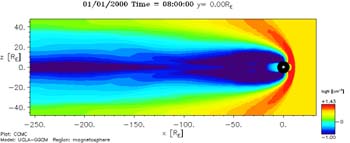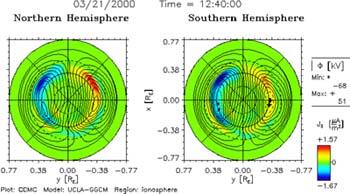Quoted from: https://ccmc.gsfc.nasa.gov/models/modelinfo.php?model=OpenGGCM
Model Description
 The Open Geospace General Circulation Model (Open GGCM) was originally developed as a magnetohydrodynamic (MHD) model of Earth's magnetosphere at UCLA in the early 1990's by J. Raeder. Besides solving the resistive MHD equations in the magnetosphere the model included a rather crude ionospheric boundary condition consisting of a ionosphere potential solver that served to close the magnetospheric field-aligned currents in the ionosphere and thus coupled magnetospheric convection with ionospheric convection. Subsequently the ionosphere end of the model was improved by adding a magnetosphere-ionosphere coupling module that not only mapped the field-aligned currents into the ionosphere and the potential back into the magnetosphere, but also computed electron precipitation parameters and the ionospheric Hall and Pedersen conductances using empirical relations in a self-consistent manner. In the late 90's this model was coupled with CTIM (Coupled Thermosphere Ionosphere Model, developed by T. Fuller-Rowell, NOAA/SEC), a sophisticated three-dimensional dynamical models of the thermosphere and ionosphere. CTIM takes the potential and the electron precipitation parameters from the MHD model and provides in turn the conductances and the ionospheric dynamo current to the potential solver. CTIM thus replaces the empirical conductance calculations with first-principle calculations. However, it also adds substantial physics to the model, and its outputs are highly relevant space weather parameters, such as the ionospheric electron parameters (Nmf2, hmf2) and neutral densities and composition. The coupled model was known for some time as the UCLA/NOAA GGCM and is now Open GGCM.
The Open Geospace General Circulation Model (Open GGCM) was originally developed as a magnetohydrodynamic (MHD) model of Earth's magnetosphere at UCLA in the early 1990's by J. Raeder. Besides solving the resistive MHD equations in the magnetosphere the model included a rather crude ionospheric boundary condition consisting of a ionosphere potential solver that served to close the magnetospheric field-aligned currents in the ionosphere and thus coupled magnetospheric convection with ionospheric convection. Subsequently the ionosphere end of the model was improved by adding a magnetosphere-ionosphere coupling module that not only mapped the field-aligned currents into the ionosphere and the potential back into the magnetosphere, but also computed electron precipitation parameters and the ionospheric Hall and Pedersen conductances using empirical relations in a self-consistent manner. In the late 90's this model was coupled with CTIM (Coupled Thermosphere Ionosphere Model, developed by T. Fuller-Rowell, NOAA/SEC), a sophisticated three-dimensional dynamical models of the thermosphere and ionosphere. CTIM takes the potential and the electron precipitation parameters from the MHD model and provides in turn the conductances and the ionospheric dynamo current to the potential solver. CTIM thus replaces the empirical conductance calculations with first-principle calculations. However, it also adds substantial physics to the model, and its outputs are highly relevant space weather parameters, such as the ionospheric electron parameters (Nmf2, hmf2) and neutral densities and composition. The coupled model was known for some time as the UCLA/NOAA GGCM and is now Open GGCM.
Basic model concept:
For the numerical details we refer to the literature cited below. Briefly, the magnetospheric part solves the MHD equations on a stretched Cartesian grid using second order explicit time integration with conservative and flux-limited spatial finite differences. A Yee grid is used to preserve the magnetic field divergence to round-off error. The code is parallelized using the message passing interface (MPI) and runs on a large variety of computers that support MPI. Currently the code is used on IBM-SP2, IBM-p690, SGI-Origin2000, HP/alpha based machines, and on a variety of Intel or AMD based Beowulf clusters. The code scales well up to 100s of processors on machines with high speed interconnect (IBM, SGI, Myrinet clusters), and up to several 10s of CPUs on Gbit Ethernet based clusters. The numerical grid is adaptable and can have from a few times 10^5 to more than 10^8 cells. Correspondingly, the resolution in the MHD grid near the sub-solar magnetopause can be as small as 100 km or as large as 0.5 RE. The code is robust and efficient. Real-time operation can be achieved with a moderately fine grid (~10^6 cells) using about 20 CPUs. At the ionosphere side, the code can either be run with uniform conductance, an empirical conductance model, or with CTIM.
 Model use and outputs:
Model use and outputs:
The output of the model consists of snapshots of the full 3d grid of the primary variables (density, pressure, velocity, magnetic field, current density), snapshots on pre-defined 2d cuts perpendicular to any of the axes, snapshots of the ionospheric quantities (FAC, potential, electron precipitation fluxes and energies, ground magnetic perturbations), and if run with CTIM, also snapshots of the CTIM variables (neutral density, composition, winds, temperature, ion and electron densities and temperatures). Since the output can be virtually unlimited a judicious choice must be made before each run of which parameters are needed for analysis and at which cadence. It is easily possible to create 100GB or more with one run.
Model Input
Inputs to Open GGCM are solar wind plasma and magnetic field conditions propagated from a solar wind monitor satellite to the upstream simulation box boundary. The Earth magnetic field is approximated by a dipole with fixed orientation during the entire simulation run. The orientation angle can be specified independently from the time interval simulated.
Model Output
Outputs include the magnetospheric plasma parameters (density N, plasma pressure P, velocity V_x, V_y, V_z, magnetic field B_x, B_y, B_z, current densities, J_x, J_y, J_z), and ionospheric parameters (electric potential, FAC, Hall and Pedersen conductances Sigma_H, Sigma_P), electron precipitation mean energy and energy flux. In addition, for runs with CTIM the 3d dynamical thermosphere and ionosphere parameters can be obtained.
Derived Quantities:
Numerous quantities can be derived from the primary outputs. Of particular interest are: (i) magnetic field topology, (ii) the open-closed (polar cap) boundary in the ionosphere, (iii) auroral luminosity, and (iv) ground magnetic perturbations. Most of these quantities require some post-processing, for example, tracing of a large number of field lines.
Limitations and Caveats
The model does not include the energetic particle drift and ring current physics. Thus, results within about 5 RE from Earth are generally meaningless. Likewise, there is no plasmasphere. This should not affect the dynamics of the magnetosphere much, however, wave propagation through the inner magnetosphere is affected. Also, the model uses a `Boris correction' to keep time steps manageable. As a consequence wave propagation in the inner magnetosphere is artificially slowed. The developers do not provide any guarantee for the correctness of model results. There are many more caveats of various natures than listed here. Users of the model are therefore highly encouraged to contact the developers and discuss results with them prior to any publication. Users should also consult the Open GGCM web site.
References and relevant publications
- Fuller-Rowell, T. J., et al., A coupled thermosphere ionosphere model (CTIM), in: STEP Report, R. W. Schunk ed., Scientific Committee on Solar Terrestrial Physics, NOAA/NGDC, Boulder, CO, 239, 1996.
- Raeder, J., J. Berchem, and M. Ashour-Abdalla, The geospace environment grand challenge: Results from a global geospace circulation model, JGR, 103, 14787, 1998. (Introduction and test of the ionosphere model)
- Raeder, J., and V. Angelopoulos, Using global simulations of the magnetosphere for multi-satellite mission planning and analysis, in: Science Closure and Enabling Technologies for Constellation Class Missions, UCB and NASA GSFC pub 78, 1998. (An example of how to use the global model to help define missions)
- Raeder, J., Modeling the magnetosphere for northward interplanetary magnetic field: Effects of numerical resistivity, JGR, 104, 17353, 1999. (discusses the effects of numerical diffusion on model results)
- Raeder, J., Reply, JGR, 105, 13149, 2000. (Further discussion of diffusive effects)
- Raeder, et al., Global simulation of the geospace environment modeling substorm challenge event, JGR, 106, 381, 2001. (First realistic substorm simulation, extensive comparison withy in situ data, shows some limitations with regard to substorm modeling)
- Raeder, J., Y. L. Wang, T. J. Fuller-Rowell, Geomagnetic storm simulation with a coupled magnetosphere-ionosphere-thermosphere model, in: Space Weather: Progress and Challenges in Research and Applications, P. Song, H. J. Singer, and G. Siscoe, eds.,
Geophysical Monograph, 125, AGU, Washington D.C., 377, 2001. (Shows how CTIM affects storm results)
- Raeder, J., Y. L. Wang, T. J. Fuller-Rowell, and H. J. Singer, Global simulation of space weather effects of the Bastille Day storm, Solar Phys., 204, 325, 2001. (Shows which space weather effects can be modeled and the model limitations)
- Raeder, J., Global geospace modeling: Tutorial and review, in: Space Plasma Simulation, Lecture Notes in Physics, vol. 615, Springer Verlag, Heidelberg, 2003. (A general introduction to physical and numerical principles of geospace modeling)
Relevant links
CCMC Contact(s)
Lutz Rastaetter
301-286-1085
Developer Contact(s)
Joachim Raeder
phone: S603 862-3412
fax: 603-862-3584
Space Science Center
University of New Hampshire
39 College Road
Durham, NH 03824-3525
Office: 245G Morse Hall
Timothy Fuller-Rowell (for CTIM related issues)
phone: 303-497-5764
NOAA R/E/SE, Space Environment Center
325 Broadway
Boulder, CO 80303



 The Open Geospace General Circulation Model (Open GGCM) was originally developed as a magnetohydrodynamic (MHD) model of Earth's magnetosphere at UCLA in the early 1990's by J. Raeder. Besides solving the resistive MHD equations in the magnetosphere the model included a rather crude ionospheric boundary condition consisting of a ionosphere potential solver that served to close the magnetospheric field-aligned currents in the ionosphere and thus coupled magnetospheric convection with ionospheric convection. Subsequently the ionosphere end of the model was improved by adding a magnetosphere-ionosphere coupling module that not only mapped the field-aligned currents into the ionosphere and the potential back into the magnetosphere, but also computed electron precipitation parameters and the ionospheric Hall and Pedersen conductances using empirical relations in a self-consistent manner. In the late 90's this model was coupled with CTIM (Coupled Thermosphere Ionosphere Model, developed by T. Fuller-Rowell, NOAA/SEC), a sophisticated three-dimensional dynamical models of the thermosphere and ionosphere. CTIM takes the potential and the electron precipitation parameters from the MHD model and provides in turn the conductances and the ionospheric dynamo current to the potential solver. CTIM thus replaces the empirical conductance calculations with first-principle calculations. However, it also adds substantial physics to the model, and its outputs are highly relevant space weather parameters, such as the ionospheric electron parameters (Nmf2, hmf2) and neutral densities and composition. The coupled model was known for some time as the UCLA/NOAA GGCM and is now Open GGCM.
The Open Geospace General Circulation Model (Open GGCM) was originally developed as a magnetohydrodynamic (MHD) model of Earth's magnetosphere at UCLA in the early 1990's by J. Raeder. Besides solving the resistive MHD equations in the magnetosphere the model included a rather crude ionospheric boundary condition consisting of a ionosphere potential solver that served to close the magnetospheric field-aligned currents in the ionosphere and thus coupled magnetospheric convection with ionospheric convection. Subsequently the ionosphere end of the model was improved by adding a magnetosphere-ionosphere coupling module that not only mapped the field-aligned currents into the ionosphere and the potential back into the magnetosphere, but also computed electron precipitation parameters and the ionospheric Hall and Pedersen conductances using empirical relations in a self-consistent manner. In the late 90's this model was coupled with CTIM (Coupled Thermosphere Ionosphere Model, developed by T. Fuller-Rowell, NOAA/SEC), a sophisticated three-dimensional dynamical models of the thermosphere and ionosphere. CTIM takes the potential and the electron precipitation parameters from the MHD model and provides in turn the conductances and the ionospheric dynamo current to the potential solver. CTIM thus replaces the empirical conductance calculations with first-principle calculations. However, it also adds substantial physics to the model, and its outputs are highly relevant space weather parameters, such as the ionospheric electron parameters (Nmf2, hmf2) and neutral densities and composition. The coupled model was known for some time as the UCLA/NOAA GGCM and is now Open GGCM. Model use and outputs:
Model use and outputs:




